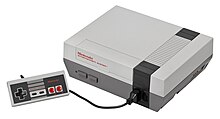Nintendo Entertainment System - Simple English Wikipedia, the free encyclopedia
Top: North American/European NES control deck with controller, similar to the South Korean Comboy Bottom: Japanese/Taiwanese/Hong Kong Family Computer ("Famicom") main unit (with the hardwired controllers) | |
| Also known as | Family Computer/Famicom (Japan) Hyundai Comboy (Korea) |
|---|---|
| Developer | Nintendo R&D2 |
| Manufacturer | Nintendo |
| Type | Home video game console |
| Generation | Third generation |
| Release date | |
| Lifespan | 1983–2003 (Famicom)[2] 1985–1995 (NES) |
| Introductory price | ¥14,800 (Japan) $179 (US Deluxe Set)[3] |
| Discontinued | |
| Units sold | Worldwide: 61.91 million Japan: 19.35 million America: 34.00 million Other: 8.56 million[7] |
| Media | ROM cartridge ("Game Pak")b[›] |
| CPU | Ricoh 2A03 8-bit processor (MOS Technology 6502 core) |
| Controller input | 2 controller portsc[›] 1 expansion slot |
| Best-selling game |
|
| Predecessor | Color TV-Game series |
| Successor | Super Nintendo Entertainment System |
| Related articles | Famicom Disk System, Famicom 3D System |
The Nintendo Entertainment System (NES) is the first video game console made by Nintendo in Japan, Europe, and the United States. It came out in 1985 in the United States and was very popular. In Japan, the console looked different and was called the Famicom (from Family Computer).
The controller for the NES was different from the joysticks that older consoles had. It had a D-pad button that could go up, down, left, or right. It also had A, B, Select, and Start buttons. The NES could use up to two controllers for multiplayer games. There were also other types of controllers that could be used with the NES.
Some famous games for the NES are Super Mario Bros., The Legend of Zelda, Metroid, Mega Man, Castlevania, Donkey Kong, and Final Fantasy. There have been many sequels to these games. Nintendo discontinued (stopped making and selling) the NES in 1995 and the Famicom in 2003.
Background
[change | change source]In 1983, Nintendo, a relatively small arcade company, released the Family Computer (Famicom for short) in Japan. It ended up selling really well, but Nintendo kept it in Japan. Nintendo then thought about using Atari, who was dominating the North American video game market, to distribute the system. Plans changed though when the Video game crash of 1983 happened. The crash was because of too many consoles, poorly made games, and bad business practices. All the gaming companies began to lose money, and everyone in North America stopped buying video games. Nintendo, though, still thought they could have a chance to bring the Famicom to North America. In early 1985, at an electronics show, they showed off the Advanced Video System, which looked more futuristic, used wireless controllers, and looked much different than other gaming consoles. It received a lot of attention, but no one bought anything. Nintendo then renamed the system the Nintendo Entertainment System and made it look like a VCR. In October 1985, Nintendo decided to rent a small warehouse in New York City and quietly launched the console. Nintendo wasn't sure if it would work, but released it anyway. Some launch titles were Super Mario Bros., various sports games, and ported arcade games like Donkey Kong. It also came packaged with R.O.B. the Robot. It would turn out to be a huge success, and the gaming industry was revived. It would sell over 60 million units. The console after it was called the Super Nintendo Entertainment System and it launched in 1991, but the NES would still be supported until 1995.
Technical details
[change | change source]The CPU (central processing unit) in the NES is called MOS 6502 and is an 8-bit CPU. The chip that contains the CPU also contains other electronics that generate sound for games and help with some other things. There are two different versions of the chip called 2A03 and 2A07 that are used in different regions of the world (2A03 works with NTSC TVs, 2A07 with PAL TVs). It was made by a company called Ricoh.
The NES uses a chip called the PPU (Picture Processing Unit) to draw graphics on the TV. It has two different versions, called 2C02 (for NTSC TVs) and 2C07 (for PAL TVs). It was also made by Ricoh.
The NES has a connector on the bottom, but it was not used for anything.
Related pages
[change | change source]References
[change | change source]- ↑ "Oct. 18, 1985: Nintendo Entertainment System Launches". WIRED. October 18, 2010. Retrieved June 11, 2015.
- ↑ "Nintendo Co., Ltd. : Consolidated Sales Transition by Region" (PDF). Nintendo.co.jp. Retrieved August 8, 2018.
- ↑ Levin, Martin (November 20, 1985). "New components add some Zap to video games". San Bernardino County Sun. p. A-4.
- ↑ Nintendo to end Famicom and Super Famicom production. GameSpot.com (May 30, 2003). Retrieved on August 23, 2013.
- ↑ "Nintendo Entertainment System (NES) – 1985–1995". Classic Gaming. IGN. Archived from the original on 2012-03-11. Retrieved 2010-07-19.
- ↑ L'Histoire de Nintendo volume 3 p. 113 (Ed. Pix'n Love, 2011)
- ↑ "Consolidated Sales Transition by Region" (PDF). First console by Nintendo. January 27, 2010. Archived from the original (PDF) on February 14, 2010. Retrieved February 14, 2010.
- ↑ Stuart, Keith (September 13, 2010). "Super Mario Bros: 25 Mario facts for the 25th anniversary". the Guardian. Retrieved November 2, 2018.
- ↑ "Super Mario Bros voted greatest computer game ever". The Daily Telegraph. July 27, 2008. Retrieved July 22, 2010.
- ↑ Goss, Patrick. "The games that sold consoles". MSN. Archived from the original on March 9, 2008. Retrieved September 24, 2011.


 French
French Deutsch
Deutsch

